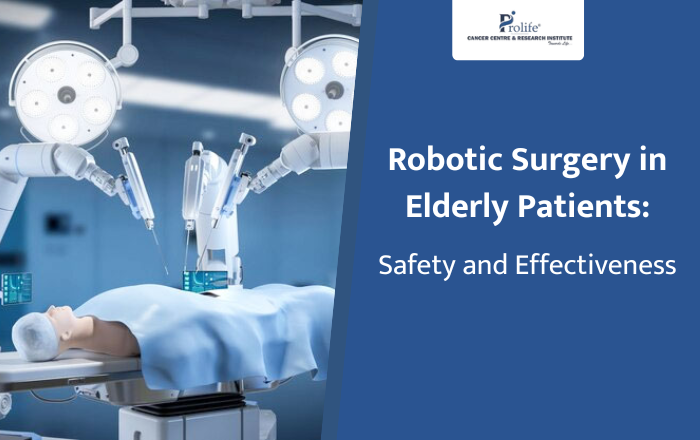
- August 22, 2019
Robotic Surgery in Elderly Patients – How Safe and Effective Is It?
As people live longer, more seniors are facing surgeries for health conditions like cancer, prostate issues, or kidney problems. Years ago, these operations carried high risks for older patients. But today, medical technology has changed how surgery is done. One of the biggest changes is robotic surgery a system that helps doctors operate with greater control and accuracy.
For elderly patients, this type of surgery can mean smaller cuts, less pain, shorter hospital stays, and faster recovery. Still, it’s natural to wonder how safe and effective is robotic surgery in elderly patients? Let’s look at what it really means, what the benefits and risks are, and how seniors can decide if it’s the right choice.
What Is Robotic Surgery?
Robotic surgery uses a computer-assisted system where the surgeon controls robotic arms equipped with tiny instruments and a camera. Think of it as giving surgeons superhuman steadiness and precision. The surgeon sits at a console and guides the robot’s movements while viewing a magnified 3D image of the surgical area.
Unlike traditional open surgery that requires large incisions, robotic procedures use several small cuts—usually less than an inch each. This approach causes less trauma to the body, which is especially important for older patients whose bodies may take longer to heal.
Why Consider Robotic Surgery for Seniors?
▹Faster Recovery
Elderly patients who undergo robotic surgery typically spend less time in the hospital—often just 1-2 days compared to 4-7 days with traditional surgery. Shorter hospital stays mean less risk of hospital-acquired infections and quicker return to familiar home surroundings.
▹Less Pain and Discomfort
Smaller incisions mean less pain after surgery. Many patients need fewer pain medications, which is beneficial since elderly patients often have concerns about medication side effects or interactions with other medicines they take.
▹Reduced Blood Loss
Studies show that robotic procedures result in significantly less blood loss. For elderly patients who may have heart or circulation issues, this is a major advantage. Less blood loss also means fewer blood transfusions.
▹Lower Infection Risk
The small incisions used in robotic surgery have lower infection rates compared to large open wounds. Since older patients may have weakened immune systems, this reduced infection risk is crucial.
Is It Actually Safe for Older Adults?
Research consistently shows that robotic surgery is safe for elderly patients, including those in their 80s and 90s. A study published in medical journals found that patients over 75 who had robotic surgery experienced fewer complications than those who had traditional open surgery.
The key isn’t the number on your birth certificate—it’s your overall health. Doctors look at factors like:
- Heart and lung function
- Ability to tolerate anesthesia
- Other existing health conditions
- Overall mobility and strength
Many elderly patients with well-managed diabetes, controlled blood pressure, or stable heart conditions successfully undergo robotic procedures every day.
Common Procedures for Elderly Patients
Robotic surgery is used to treat various conditions in older adults:
- Cancer Treatment: Prostate, kidney, colon, lung, and gynecological cancers are commonly treated with robotic surgery. The precision allows surgeons to remove tumors while protecting surrounding healthy tissue.
- Urological Issues: Beyond cancer, robotic surgery helps with kidney problems and urinary conditions that affect quality of life.
- Heart Procedures: Some cardiac surgeries can now be performed robotically, offering hope to patients who might otherwise be considered too frail for open-heart surgery.
What Does Recovery Look Like?
Most elderly patients are walking within hours of their procedure. This early movement is important—it prevents blood clots and pneumonia, two serious risks for bedridden seniors.
Pain is typically managed with regular medication, and most patients find they need less pain relief than expected. Within 2-4 weeks, many return to light daily activities like short walks and light household tasks.
Complete healing takes about 6-8 weeks, but the timeline varies based on the specific procedure and individual health. Your doctor will provide clear guidelines about activity restrictions and follow-up appointments.
Important Considerations
While robotic surgery offers many benefits, it’s not right for everyone. Some situations may require traditional surgery, such as:
- Very large tumors
- Extensive disease spread
- Certain anatomical factors
- Emergency situations
Your surgical team will evaluate your specific case and recommend the best approach.
Questions to Ask Your Doctor
Before deciding on robotic surgery, have an open conversation with your healthcare provider:
- Based on my health and condition, am I a good candidate?
- What are the benefits and risks in my specific case?
- How many robotic procedures have you performed on patients my age?
- What would recovery look like for me?
- What are the alternatives if robotic surgery isn’t suitable?
Get Expert Guidance in Pune
If you’re considering robotic surgery for yourself or an elderly family member, consulting with an experienced surgeon is essential. Dr. Sumit Shah at Prolife Cancer Centre in Pune specializes in robotic surgery procedures, including cancer treatment for patients of all ages.
Dr. Shah understands the unique needs of elderly patients and takes time to explain options clearly to both patients and families. His approach focuses on safety, realistic expectations, and supporting patients through every step of their journey.
Schedule a consultation at Prolife Cancer Centre to discuss whether robotic surgery is the right choice for you or your loved one. Don’t let concerns about age prevent you from exploring treatment options that could improve quality of life.
Frequently Asked Questions
Not necessarily. Many people in their 70s and even 80s have successfully undergone robotic surgery. The key is evaluating overall health before the procedure.
Common examples include prostate, kidney, colon, and certain cancer surgeries.
Recovery is usually quicker than with open surgery. Many patients return to normal routines within a few weeks, depending on the type of surgery.
